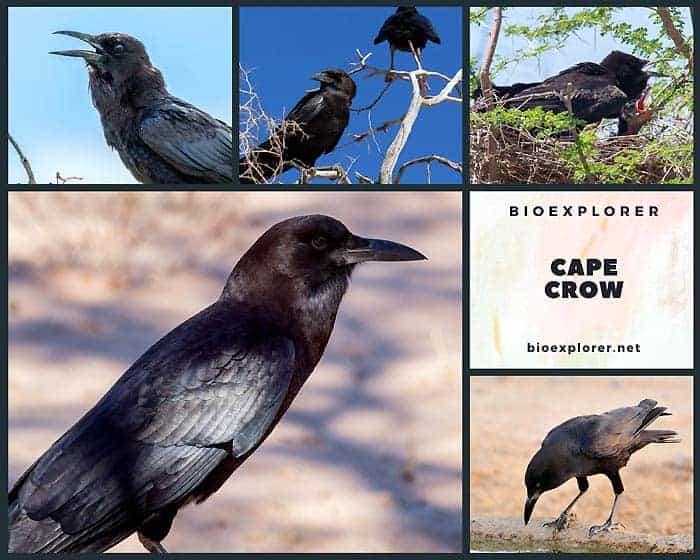
| Animalia | Passeriformes | Corvidae | Corvus | Corvus capensis |
The Cape crow, scientifically known as Corvus capensis, is a distinctive corvid found across eastern and southern Africa. This species has a broad distribution extending from Ethiopia and Somalia in the north to the Cape in South Africa.
This wholly black bird is characterized by its uniquely large, curved bill that sets it apart from other African crows. The Cape crow inhabits various environments, including open woodland, agricultural areas, and grassland habitats, where it plays important ecological roles as both predator and scavenger.
Unlike many other types of crows that have adapted well to urban environments, the Cape crow prefers rural landscapes with scattered trees for nesting and roosting.
Though sometimes considered a pest by farmers due to crop damage, the species provides valuable ecosystem services through pest control and carrion removal. It is one of the many types of birds that contribute to ecological balance in its native range.
Table of Contents
- Common Name: Cape crow, black crow.
- Family: Corvidae
- Body Dimensions: About 19-20 inches in length, 39-43 inches in wingspan.
- Male Plumage Colors: Glossy black with purple gloss.
- Female Plumage Colors: Glossy black with purple gloss.
- Habitat: Open grassland, cropland, savanna, moorland.
- Diet: Invertebrates, seeds, grains, small vertebrates.
- Native Countries: Angola, Zambia, Namibia, Botswana, Zimbabwe, Mozambique, South Africa, Ethiopia, Kenya, Tanzania, South Sudan.
- Continent: Africa
Cape Crow Characteristics
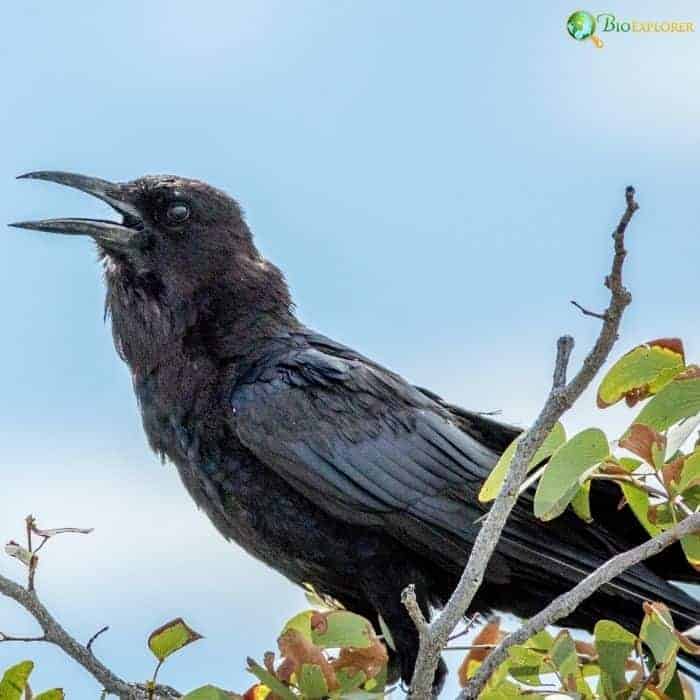
The Cape crow is a large corvid species with distinctive physical characteristics that help distinguish it from other African crows.
- It measures approximately 19-20 inches in length, making it similar in size to other large crows but with several unique features.
- The most notable physical trait is its bill, which is remarkably large and curved compared to other crow species. This specialized bill is broad at the base and prominently arched, giving the Cape crow an almost raven-like appearance in profile.
- The plumage of the Cape crow is entirely glossy black with a purplish sheen that becomes particularly visible in good lighting conditions. This uniform black coloration helps differentiate it from the Pied Crow (Corvus albus), which features distinctive white patches on its neck and chest.
- The Cape crow’s wings are broad and somewhat rounded, with primaries that spread like fingers during flight, creating a characteristic silhouette against the sky.
- The eyes of the Cape crow are dark brown, and it possesses strong black legs and feet typical of corvids.
- Males and females appear virtually identical in plumage and structure, showing minimal sexual dimorphism. However, males may be slightly larger on average.
- Juvenile Cape crows closely resemble adults but may display slightly less glossy plumage and a less pronounced bill curve until they reach full maturity.
- Vocally, the Cape crow also stands apart from other birds of Africa. Its call is a deep, hollow-sounding “krrah” or “kah” that differs distinctly from the typical cawing sounds associated with many other crow species.
One of the most distinctive aspects of the Cape crow’s appearance is its perched profile. The large, curved bill and somewhat elongated neck create a silhouette experienced birdwatchers can recognize even at a distance.
Cape Crow Habitat
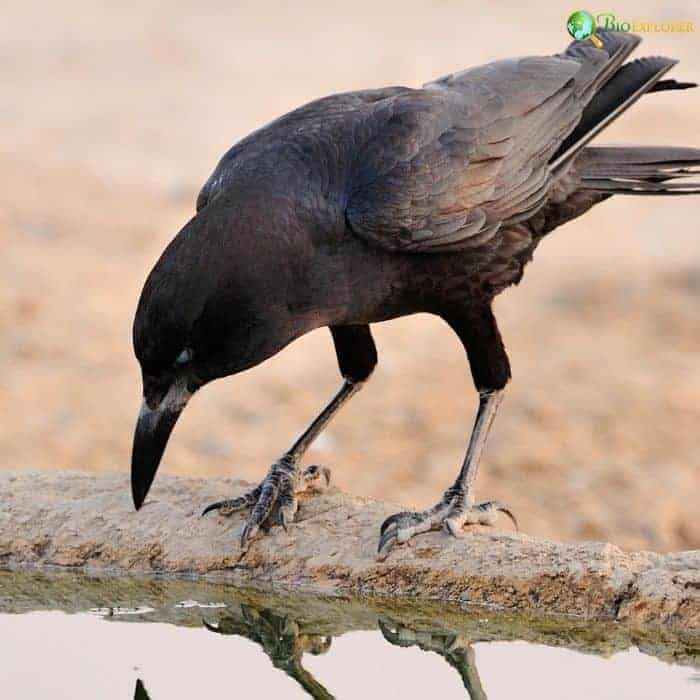
The Cape crow occupies a diverse range of habitats across its extensive distribution in eastern and southern Africa.
- Cape crow primarily inhabits open woodland, wooded grasslands, forest edges, and agricultural landscapes, showing a marked preference for areas with scattered trees that provide suitable nesting sites and vantage points. The species avoids dense forests and extremely arid regions, favoring transitional ecological zones.
- Geographically, Cape crows range from Ethiopia and Somalia in the north through eastern Africa, including Tanzania, Kenya, and Uganda, and extend southward through Malawi, Zambia, Zimbabwe, Mozambique, and into South Africa. Within South Africa, they are most common in the eastern regions, including KwaZulu-Natal, Eastern Cape, Free State, and parts of Gauteng and Mpumalanga.
While Cape crows have adapted well to certain human-modified landscapes, particularly agricultural areas, they generally maintain a more rural distribution than other corvid species that have become highly urbanized.
They can be observed in farmlands, particularly cultivated areas where plowing exposes invertebrates and other potential food items.
Unlike some corvids, Cape crows are not considered truly migratory. However, they may undertake local movements in response to seasonal food availability. This habitat flexibility and capacity for local movement have helped the species maintain relatively stable populations despite ongoing landscape transformation across parts of their range.
Diet and Hunting Behavior
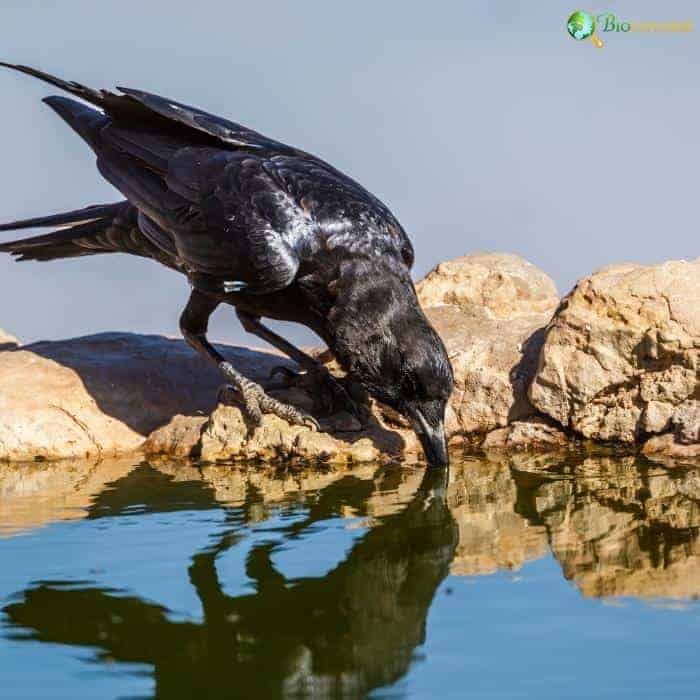
The Cape crow is a highly opportunistic omnivore with a remarkably diverse diet reflecting the adaptability typical of the corvid family.
- These intelligent birds consume various foods, including different types of insects and other invertebrates, small vertebrates, eggs, carrion, grain, and various types of plants. Their feeding strategy varies seasonally and regionally based on resource availability.
- When foraging, Cape crows display considerable versatility in their techniques. They are frequently observed methodically walking across open ground, carefully inspecting the soil and vegetation for potential prey.
- Their specialized, curved bill proves particularly effective for probing beneath the surface of soil or leaf litter to extract hidden invertebrates. During insect emergences, particularly termite flights following rains, Cape crows will gather to feast on the abundant flying insects, sometimes catching them in mid-air.
Like many corvids, Cape crows demonstrate tool use and problem-solving when feeding.
- They have been observed dropping hard items like nuts or eggs from a height to break them open on hard surfaces. They also select appropriately sized sticks to extract insects from crevices.
- Unlike more gregarious corvid species that may form large feeding flocks, Cape crows typically forage solitarily, in pairs, or in small family groups. This feeding flexibility has allowed them to thrive across diverse habitats throughout their extensive African range.
Breeding Behavior
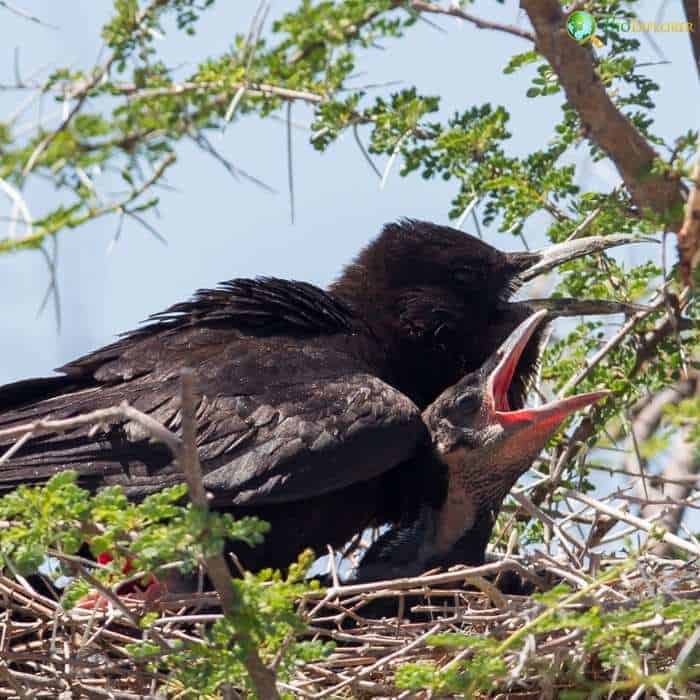
The Cape crow exhibits sophisticated breeding behaviors characterized by strong pair bonding and extended parental care.
- These black birds are monogamous, typically forming long-term pair bonds that persist across multiple breeding seasons. The breeding cycle begins with courtship, which includes mutual preening, synchronized calling, and aerial displays where pairs fly together performing coordinated maneuvers.
- Breeding seasons vary somewhat across the species’ extensive range but generally correspond with local rainfall patterns that ensure adequate food availability for raising young. In southern Africa, nesting typically occurs from September to December, coinciding with the spring and early summer months. Pairs maintain breeding territories that they defend vigorously against intruding conspecifics.
- The female typically lays 3-4 eggs per clutch. These eggs display the characteristic corvid coloration of pale bluish-green with brown speckles. Both parents participate in incubation duties, though the female handles most of these tasks.
- The incubation lasts approximately 18-19 days, during which the male often provides his mate with food and assists in territory defense. After hatching, the nestlings remain there for approximately 4-5 weeks.
Once fledged, juvenile Cape crows remain with their parents for several months, during which they learn essential foraging techniques and predator recognition through observation and parental guidance.
Young birds typically disperse from their natal territories before the next breeding season. However, some may remain nearby and occasionally assist with subsequent broods, suggesting the possibility of cooperative breeding behaviors in certain circumstances.
Interactions with Other Wildlife
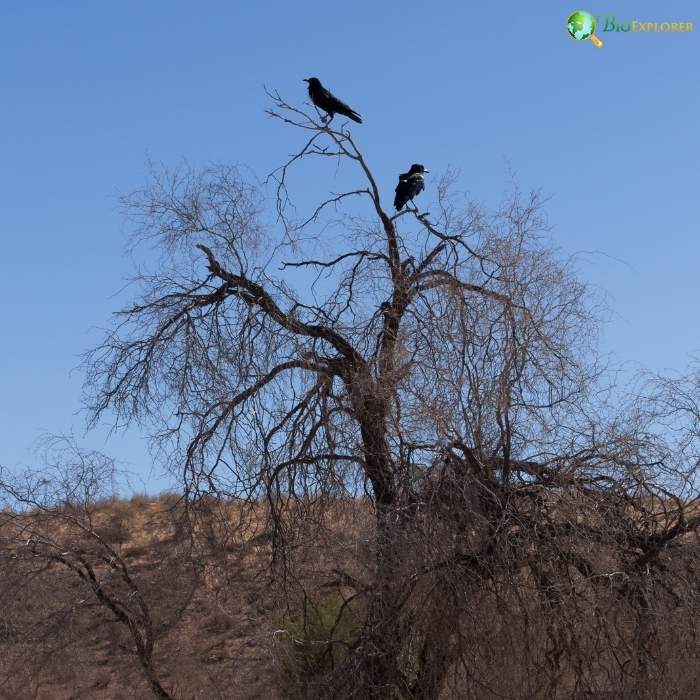
As medium-sized predators, these crows influence local bird populations through nest predation, targeting eggs and nestlings of ground-dwelling smaller birds such as domestic chickens.
- Their role as secondary consumers in ecological pyramids highlights their impact on energy flow and population dynamics. This predatory behavior has evolutionary implications, driving defensive strategies among prey species, particularly mobbing behaviors where small birds cooperatively repel intruding crows.
- Despite being predators themselves, Cape crows must remain vigilant against larger raptors such as eagles and large owls that occasionally prey on them. When threatened, they employ sophisticated alarm calls to warn conspecifics. They may engage in coordinated mobbing to drive away potential predators, particularly during the breeding season. This displays their advanced social communication system, which is typical of intelligent corvids.
Cape crows maintain interesting relationships with larger mammals in their habitat.
- They have been observed following grazing ungulates to catch various insects disturbed by the mammals’ movements, demonstrating opportunistic commensal relationships.
- Similarly, they sometimes associate with troops of baboons or vervet monkeys, capitalizing on feeding opportunities created by the primates’ foraging activities.
In agricultural landscapes, Cape crows interact significantly with human activities, sometimes benefiting from crop cultivation that creates feeding opportunities, but also coming into conflict with farmers when perceived as pests.
Ecological Importance of Cape Crows
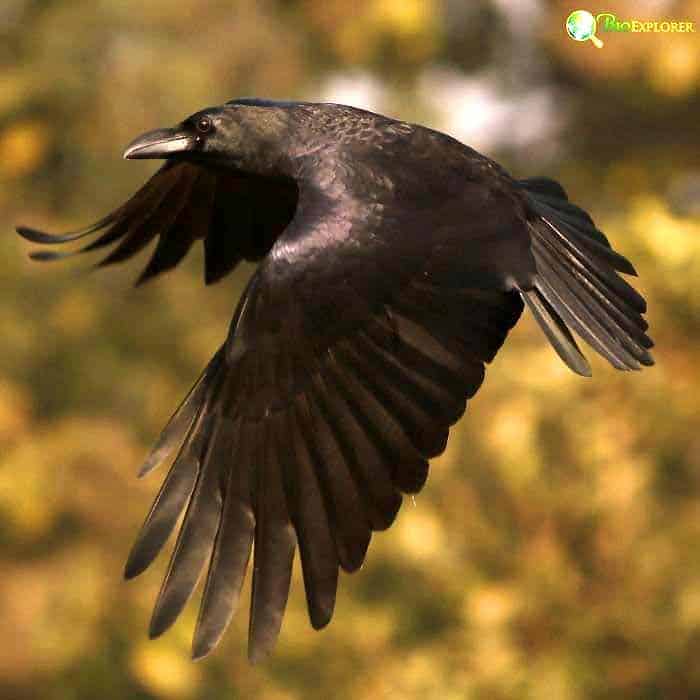
The Cape crow currently enjoys a conservation status of “Least Concern” according to the International Union for Conservation of Nature (IUCN) Red List assessment. This classification reflects the species’ relatively stable population across its extensive range in eastern and southern Africa.
- The global population is estimated to fall between 100,000 and 499,999 mature individuals. However, precise numbers remain difficult to determine due to the bird’s wide distribution across multiple countries.
- While the population trend appears stable, the Cape crow faces several anthropogenic threats that warrant monitoring. Habitat transformation due to agricultural expansion creates mixed effects. While crows can adapt to farmlands, the intensification of agriculture and associated pesticide use potentially threatens their food sources.
Additionally, the species occasionally experiences persecution from farmers who consider them agricultural pests due to crop damage and predation on poultry.
- From an ecological perspective, Cape crows provide significant ecosystem services that highlight their importance in African landscapes.
- As omnivorous predators, they contribute to controlling insect populations, particularly during pest outbreaks that can damage crops and natural vegetation. Their scavenging behavior assists nutrient recycling and disease limitation by removing carrion from the environment.
Cape Crow Fun Facts
- Cape crows have a unique way of drinking. They often dip their bills into water and then tilt their heads back to swallow, a behavior seen when they visit waterholes in drier regions.
- Cape crows are known for their acrobatic flight displays. They sometimes perform aerial rolls and swoops, especially during social interactions or when agitated.
- Cape crows are sometimes called “Black Crows” in older literature. This alternative name remains in some regional bird guides and historical accounts.
- This species has a documented fondness for shiny objects. Particularly, observers have noted Cape crows picking up and carrying away small, reflective items. However, the purpose of this behavior is not fully understood.
- They are one of the few African crows that rarely enter dense forests. Their preference for open habitats is so strong that they are seldom, if ever, recorded in closed-canopy woodland.
- Cape crows are sometimes seen following fires: They take advantage of insects and small animals fleeing the flames, a testament to their opportunistic nature.
- Their nests are often reused; pairs may refurbish and use the same nest for several consecutive years if undisturbed.
- Cape crows are sometimes observed “shadowing” large birds of prey. Watching the Raptors’ behavior may help them locate food or avoid danger.
- Despite their ability to make loud calls, Cape crows sometimes go hours without vocalizing, making them less conspicuous than others.
Frequently Asked Questions
Do Cape crows have any distinctive flight patterns?
Cape crows have a steady, direct flight with slow, deep wingbeats. Their broad, rounded wings and long tail give them a characteristic silhouette in the air.
Do Cape crows interact with livestock?
Cape crows are sometimes observed in pastures and agricultural fields, where they may feed on insects disturbed by grazing livestock or plowing. However, they do not have a significant direct relationship with livestock.
How do Cape crows differ from Pied Crows?
Cape crows (Corvus capensis) are most readily distinguished from the more common pied crows by their entirely black plumage, lacking the distinctive white chest and collar patch that characterizes Pied Crows.
Ecologically, Cape crows generally prefer more open woodland habitats and tend to be less associated with human settlements than the highly adaptable Pied Crows, which have successfully colonized urban environments across Africa.
How intelligent are Cape Crows compared to other corvids?
Cape Crows demonstrate the impressive cognitive abilities characteristic of the corvid family, though fewer specific studies have focused on their intelligence compared to intensively studied species like New Caledonian crows or common ravens. They exhibit sophisticated problem-solving capabilities, tool use, and exceptional spatial memory, particularly for food caching locations.
Cape Crows can recognize individual humans and adjust their behavior based on past experiences, showing evidence of complex social cognition. Their adaptability to varied environments and opportunistic feeding strategies further demonstrates their behavioral flexibility and intelligence, placing them among the cognitively advanced bird families.
What role do Cape crows play in African folklore and culture?
Across their extensive range, Cape crows feature in various African cultural traditions and folklore, though often less prominently than the more widespread Pied Crow. In some communities, corvids, including Cape crows, are associated with intelligence and cunning, figuring in stories highlighting their problem-solving abilities and perceived wisdom.
However, their nest predation habits and occasional crop damage have also led to more negative associations in agricultural communities.
The Cape crow represents a fascinating example of corvid adaptation to the diverse landscapes of eastern and southern Africa. As omnivorous predators and opportunistic scavengers, Cape crows contribute to ecosystem health through insect control, carrion consumption, and their position in complex food webs across African savannas and woodlands.
The enduring presence of Cape crows across their extensive range is a testament to these remarkable birds’ adaptability and resilience in a changing world.
![]()











